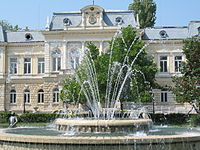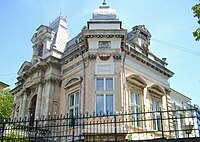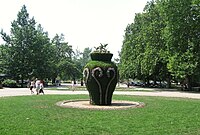Ruse, Bulgaria: Difference between revisions
| Line 112: | Line 112: | ||
* [[1879]] - the first agronomical school "Obraztsov chiflik", today - Agricultural scientific research institute, currently profiled in agriculture and seed science; <ref> http://izs-ruse.org/en/istoria.php </ref> |
* [[1879]] - the first agronomical school "Obraztsov chiflik", today - Agricultural scientific research institute, currently profiled in agriculture and seed science; <ref> http://izs-ruse.org/en/istoria.php </ref> |
||
* [[1881]] - the first steel ship in Bulgaria was built; <ref> [http://bulnas.org/en/m_rousse_shipyard.php] Bulgarian National Association of Shipbuilding and Ship repair </ref> |
* [[1881]] - the first steel ship in Bulgaria was built; <ref> [http://bulnas.org/en/m_rousse_shipyard.php] Bulgarian National Association of Shipbuilding and Ship repair </ref> |
||
* [[1881]] - the first privately-owned Bulgarian bank [[Girdap]]; |
|||
* [[1881]] - the [[Nikola_Vaptsarov_Naval_Academy|Machine School for the Navy]], the first technical school in Bulgaria. Later it was moved to [[Varna]]; |
|||
* [[1883]] - the first [[Weather station]]; <ref> [http://www.meteo.bg/docs/CMS_Sof_Hystory_Web.pdf] БАН - "120 ГОДИНИ ОТ НАЧАЛОТО НА РЕДОВНИТЕ МЕТЕОРОЛОГИЧНИ НАБЛЮДЕНИЯ В БЪЛГАРИЯ." </ref> |
|||
* [[1884]] - the first bulgarian pharmacy association; <ref> [http://bphu.eu/about_us.php?id_page=2] Българският фармацевтичен съюз(БФС) </ref> <ref> в. "Славянин" бр. 117 от 1884 г. </ref> |
|||
* [[1885]] - the first Bulgarian technical association was instituted;<ref> [http://www.fnts.bg/en/history_en.php] "FEDERATION OF THE SCIENTIFIC ENGINEERING UNIONS" </ref> |
|||
* [[1890]] - the first Chamber of Commerce and Industry;<ref> [http://www.rcci.bg/en/] "Русенската Търговско-Индустриална Камара" </ref> |
|||
* [[1891]] - the first private insurance company "Bulgaria"; <ref> History of world and national economy - Dimitar Sazdov, 2005, UNWE</ref> |
|||
* [[1896]] - the first manually operated elevator; <ref> [http://www.ruse.eu/index.php/bg/first/547-first-elevator] "The first elevator in Bulgaria" </ref> |
|||
* [[1987]] - the first movie projection. The second was a month later in the capital [[Sofia]]; <ref> [http://dariknews.bg/view_article.php?article_id=123002] "Движещ се трен виждат русенци на първата кинопрожекция преди 110 години" </ref> |
|||
* [[1927]] - the first socks producing factory in Bulgaria - "Fazan"; <ref> [http://www.fazansocks.com/_uk/company_en.htm] "Първата чорапена фабрика в България" </ref> |
|||
* [[1933]] - the first oil refinery; <ref> http://www.petrol.bg/history.php </ref> |
|||
Here manufactured the first bulgarian factories for soda-water, lemonade and also for neckties. <ref> [http://lib.sudigital.org/record/470/files/Almanah%20PDF.pdf] "Mеждународен алманах за България 1898. Annuaire international de la Bulgarie. 1898 / А Дюрастел" - page 443 </ref>. The first aviator Simeon Petrov was born at Ruse. <ref> [http://history.rodenkrai.com/new/bylgarska_aviaciq/pyrviqt_bylgarski_diplomiran_pilot.html] Симеон Петров – първият дипломиран пилот </ref> |
|||
In the newly-liberated Bulgaria of the late 19th century, Ruse was a cosmopolitan city with a multiethnic population. According to the first census conducted in 1883, Ruse was populated by 26,156 people, making it the largest city in Bulgaria. Its ethnic composition was: 11,342 [[Bulgarians]], 10,252 [[Turkish people|Turks]], 1,943 [[Sephardi Jews]], 841 [[Armenians]], 476 [[Germans]], 291 [[Greeks]], 231 [[Vlachs]] ([[Romanians]]), 170 [[Russians]], 113 [[Serbs]] and [[Croats]], 79 [[Romani people|Roma people]], 76 [[Hungarians]], 74 [[Tatars]], 58 [[Italians]], 58 [[French people]], 32 [[English people]], 19 [[Persian people|Persians]], 16 [[Poles]], 16 [[Czechs]], and 69 people of other nationalities.<ref name="ohrenzeuge">{{cite book|last=Angelova|first=Penka|title=Elias Canetti: Der Ohrenzeuge des Jahrhunderts|publisher=Internationale Elias-Canetti-Gesellschaft Rousse|year=2006|chapter=Die Geburtsstadt von Elias Canetti|url=http://www.archives.government.bg/tda/docs/canetti_izlojba_ruse.pdf|language=German}}</ref> |
In the newly-liberated Bulgaria of the late 19th century, Ruse was a cosmopolitan city with a multiethnic population. According to the first census conducted in 1883, Ruse was populated by 26,156 people, making it the largest city in Bulgaria. Its ethnic composition was: 11,342 [[Bulgarians]], 10,252 [[Turkish people|Turks]], 1,943 [[Sephardi Jews]], 841 [[Armenians]], 476 [[Germans]], 291 [[Greeks]], 231 [[Vlachs]] ([[Romanians]]), 170 [[Russians]], 113 [[Serbs]] and [[Croats]], 79 [[Romani people|Roma people]], 76 [[Hungarians]], 74 [[Tatars]], 58 [[Italians]], 58 [[French people]], 32 [[English people]], 19 [[Persian people|Persians]], 16 [[Poles]], 16 [[Czechs]], and 69 people of other nationalities.<ref name="ohrenzeuge">{{cite book|last=Angelova|first=Penka|title=Elias Canetti: Der Ohrenzeuge des Jahrhunderts|publisher=Internationale Elias-Canetti-Gesellschaft Rousse|year=2006|chapter=Die Geburtsstadt von Elias Canetti|url=http://www.archives.government.bg/tda/docs/canetti_izlojba_ruse.pdf|language=German}}</ref> |
||
Revision as of 07:02, 13 July 2011
Ruse
Русе | |
|---|---|
| From top left: The old city centre of Ruse, A statue of Hercules , Ruse carnival, Rousse State Opera, Monument of Liberty From top left: The old city centre of Ruse, A statue of Hercules , Ruse carnival, Rousse State Opera, Monument of Liberty | |
| Country | |
| Province (Oblast) | Ruse |
| Government | |
| • Mayor | Bozhidar Yotov |
| Elevation | 45 m (148 ft) |
| Population (Census February 2011)[1] | |
| • Total | |
| Time zone | UTC+2 (EET) |
| • Summer (DST) | UTC+3 (EEST) |
| Postal Code | 7000 |
| Area code | 082 |
Ruse (also transliterated as Rousse or Russe; Template:Lang-bg pronounced [ˈrusɛ]) is the fifth-largest city in Bulgaria. Ruse is situated in the northeastern part of the country, on the right bank of the Danube, opposite the Romanian city of Giurgiu, 300 km from the capital Sofia and 200 km from the Bulgarian Black Sea Coast. It is the most significant Bulgarian river port, serving an important part of the international trade of the country.
Ruse is known for its 19th- and 20th-century Neo-Baroque and Neo-Rococo architecture, which attracts many tourists. It is often called the Little Vienna. The Ruse-Giurgiu Friendship Bridge, the only one in the shared Bulgarian-Romanian section of the Danube, crosses the river here.
Geography
Ruse is located on the right bank of the Danube, which is the high bank, having two underwater terraces and three river terraces at 15 to 22 m (49.21–72.18 ft), 30 to 66 m (98.43–216.54 ft), and 54 to 65 m (177.17–213.25 ft). The average altitude is 45.5 m (149.28 ft) AMSL. The urban area is an approximately 11-km ellipse running along the river. The city extends from the land-connected Matey (Матей) island and the mouth of Rusenski Lom on the west to Srabcheto (Сръбчето) hill on the east. During the 20th century, the west end of the city was significantly modified by moving the mouth of Rusenski Lom to the west, as well as by moving the bank itself with its fairway considerably to the north. Sarabair (саръбаир) hill is to the south of the city and is 159 m (521.65 ft) high. The Rousse TV Tower is built there on the remains of Leventtabia, a former Turkish fortification.
Climate
| Climate data for Ruse | |||||||||||||
|---|---|---|---|---|---|---|---|---|---|---|---|---|---|
| Month | Jan | Feb | Mar | Apr | May | Jun | Jul | Aug | Sep | Oct | Nov | Dec | Year |
| Record high °C (°F) | 20 (68) |
21 (70) |
27 (81) |
33 (91) |
34 (93) |
41 (106) |
46.7 (116.1) |
43 (109) |
34 (93) |
35 (95) |
27 (81) |
22 (72) |
46.7 (116.1) |
| Daily mean °C (°F) | 0 (32) |
2 (36) |
7.5 (45.5) |
13.5 (56.3) |
19 (66) |
22.5 (72.5) |
24.5 (76.1) |
24 (75) |
20 (68) |
13.5 (56.3) |
6.5 (43.7) |
1.5 (34.7) |
12.9 (55.2) |
| Record low °C (°F) | −18 (0) |
−15 (5) |
−12 (10) |
−1 (30) |
3 (37) |
7 (45) |
11 (52) |
8 (46) |
4 (39) |
−14 (7) |
−12 (10) |
−15 (5) |
−18 (0) |
| Average precipitation mm (inches) | 12 (0.5) |
11 (0.4) |
11 (0.4) |
10 (0.4) |
11 (0.4) |
10 (0.4) |
7 (0.3) |
6 (0.2) |
6 (0.2) |
7 (0.3) |
10 (0.4) |
11 (0.4) |
112 (4.3) |
| Source: MSN Weather, http://www.weatherbase.com и http://www.weatherbase.com | |||||||||||||
History
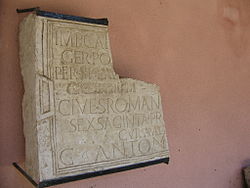
Antiquity and Early Middle Ages
The city emerged as a Neolithic settlement from the 3rd to 2nd millennium BCE, when pottery, fishing, agriculture, and hunting developed. Excavations reveal several layers, suggesting that the place was attacked by neighbouring tribes and suffered a number of natural disasters. Ancient sanctuaries were found nearby, where idols of a pregnant woman, a fertility goddess, were prevalent. The later Thracian settlement developed into a Roman military and naval centre during the reign of Vespasian (69-70 CE) as part of the fortification system along the northern boundary of Moesia. Its name, Sexaginta Prista, suggests a meaning of "a city of 60 ships" (from Template:Lang-la — "60" and Template:Lang-el — a special type of guard ship), based on the supposed 60 nearby berths. The fortress was located on the main road between Singidunum (modern Belgrade) and the Danube Delta and was destroyed in the sixth century by Avar and Slavic raids. Hungarian historian Felix Philipp Kanitz was the first to identify Sexaginta Prista with Ruse, but the Škorpil brothers demonstrated the link later through studying inscriptions, coins, graves, and objects of daily life. An inscription from the reign of Diocletian proves that the city was rebuilt as a praesidium (a large fortification) after it was destroyed by the Goths in 250 CE.
Second Bulgarian Empire and Ottoman rule
In the 13th and 14th centuries, during the time of the Second Bulgarian Empire, a fortified settlement called Rusi (also Golyamo Yorgovo; Template:Lang-bg), first mentioned in 1380, emerged near the ruins of the Roman town. It later strengthened its position as an important trade centre with the lands on the opposite side of the Danube, until it was conquered by the Ottomans in 1388. Scholars suggest that the city on the river bank derived its present name from the Cherven fortress (Template:Lang-bg; "червѐн" meaning red) through the root rous, which is present in many Slavic languages and is a cognate of French rouge and Latin rusos.[2]
During Ottoman rule, the invaders destroyed the town, reacting to a 1595 unsuccessful liberation attempt by a joint Vlach-Bulgarian army, led by Michael the Brave. After its rebuilding in the following years, Ruse was dubbed Rusçuk (Turkish for "little Ruse") and had again expanded into a large fortress by the 18th century. It later grew into one of the most important Ottoman towns on the Danube and an administrative centre of Tuna Vilayet, which extended from Varna and Tulcea to Sofia and Niš.
The "Dunav" newspaper appeared – it was the first printed in Bulgaria and ... in Bulgarian. Some Bulgarian schools were founded. The streets are renamed and numbered for the first time in Bulgarian lands. A post-office, hospital, home for the aged were founded. Three empires met here for trading: Austro-Hungary, Russia, British Empire, France and Italy opened consulates in Ruschuk. Imperceptibly, the modern city arose from the shades of the settlement. In 1865 the Obraztsov Chiflik was founded on the place where the English Consul's farm was and it was the first modern farm on the territory of the whole Ottoman Empire of that time.
Ruse developed into a centre of the Bulgarian National Revival and hosted the headquarters of the Bulgarian Revolutionary Central Committee.
Liberated Bulgaria

After it was liberated from the Ottoman Empire on 20 February 1878, Ruse was one of the key cultural and economic centres of the country. Intensive building during the period changed the city's architectural appearance to a typical Central European one. Ruse is famous for the many first innovations in Bulgaria, including:
- 1864 - the first printing office in Bulgaria; [3]
- 1867 - the first railway line linking Ruse and Varna, was launched into operation; [4]
- 1879 - the first agronomical school "Obraztsov chiflik", today - Agricultural scientific research institute, currently profiled in agriculture and seed science; [5]
- 1881 - the first steel ship in Bulgaria was built; [6]
- 1881 - the first privately-owned Bulgarian bank Girdap;
- 1881 - the Machine School for the Navy, the first technical school in Bulgaria. Later it was moved to Varna;
- 1883 - the first Weather station; [7]
- 1884 - the first bulgarian pharmacy association; [8] [9]
- 1885 - the first Bulgarian technical association was instituted;[10]
- 1890 - the first Chamber of Commerce and Industry;[11]
- 1891 - the first private insurance company "Bulgaria"; [12]
- 1896 - the first manually operated elevator; [13]
- 1987 - the first movie projection. The second was a month later in the capital Sofia; [14]
- 1927 - the first socks producing factory in Bulgaria - "Fazan"; [15]
- 1933 - the first oil refinery; [16]
Here manufactured the first bulgarian factories for soda-water, lemonade and also for neckties. [17]. The first aviator Simeon Petrov was born at Ruse. [18]
In the newly-liberated Bulgaria of the late 19th century, Ruse was a cosmopolitan city with a multiethnic population. According to the first census conducted in 1883, Ruse was populated by 26,156 people, making it the largest city in Bulgaria. Its ethnic composition was: 11,342 Bulgarians, 10,252 Turks, 1,943 Sephardi Jews, 841 Armenians, 476 Germans, 291 Greeks, 231 Vlachs (Romanians), 170 Russians, 113 Serbs and Croats, 79 Roma people, 76 Hungarians, 74 Tatars, 58 Italians, 58 French people, 32 English people, 19 Persians, 16 Poles, 16 Czechs, and 69 people of other nationalities.[19]
"All facades on main streets of Russe shall have rich decorations with plastic stone", postulate the Regulations for Constructions of Private Buildings of 1893, issued by the Municipality of Russe.
After knyaz Alexander Battenberg's 1886 abdication, and as a reaction to the regentship's course led by prime minister Stefan Stambolov, a group of Russophile (pro-Russian) military officers revolted in Ruse. The riot was violently crushed, and 13 of the leaders were quickly sentenced to death and executed near the city, which caused a lot of public discontent. Decades later, in 1934, local citizens raised funds and built a monument at the place where the Russophile officers were executed. The monument was blown up in 1940, but rebuilt in 1966 at approximately the same spot.
World War II and Socialism
Between World War I and II, after Southern Dobruja was lost to Romania, the economic significance of the city decreased. So did the population, and Ruse was no longer the second-largest city in Bulgarian lands (after former East Rumelian capital Plovdiv), being quickly surpassed by Sofia and Varna. Many big companies left, and all foreign consulates were closed, except for the Russian one, which has remained functional since.
The return of Southern Dobruja to Bulgaria in September 1940 fostered good conditions for restoration of the city's leading role. It became a provincial centre, and economic activity revived. The construction of the Ruse-Giurgiu bridge in 1954 and the fast industrialization gave a new push to development. Ruse emerged again as an important economic, transport, cultural, and educational hub. Engineering, chemical, and light industries expanded; a large harbor was built; and the city became a university centre. At the 1985 census, a population of more than 186,000 was reported.
Fall of Socialism and democratic Bulgaria
In the early 1980s, Ruse entered a dark period of its history. The Verachim factory was built in Giurgiu, which polluted the air between 1980 and 1987, impacting the city's development. Population decreased, and 15,000 people moved out between 1985 and 1992. Fortunately, in 1987, the Romanian factory ceased the pollution, under pressure from environmental organizations on both Bulgarian and Romanian communist leadership. Organizations, such as Ekoglasnost, provoked nationwide demonstrations and strongly influenced the change to democracy.
During the 1990s, the economic crisis in Bulgaria affected Ruse. Most big companies suffered a decline and unemployment increased, which led to renewed emigration waves. Since 2000, the city has been continually regaining its former leading status.
Population
Ruse is the fifth biggest city in Bulgaria by population.[20] It was the most populated city in 1880.[21]
| Ruse | ||||||||||||||||||
|---|---|---|---|---|---|---|---|---|---|---|---|---|---|---|---|---|---|---|
| Year | 1880 | 1887 | 1910 | 1934 | 1946 | 1956 | 1965 | 1975 | 1985 | 1992 | 2001 | 2006 | 2008 | 2011 | ||||
| Population* | 26 163 | 27 194 | 36 255 | 41 447 | 57 509 | 83 453 | 128 888 | 159 578 | 183 746 | 170 038 | 161 453 | 157 540 | 156 761 | 146 609 | ||||
| Permanent address | 190 798 | 177 104 | 175 374 | 173 205 | ||||||||||||||
| Current address | 179 666 | 170 208 | 168 116 | 165 208 | ||||||||||||||
- "Population" - Permanent and current address at the same place
Economy
Ruse is a big industrial centre. One of the first industrial parks in Bulgaria was built here. The French manufacturer of aluminium components for the automotive industry - Montupet and the Spanish company Keros - ceramic tiles producer, are operating at the industrial park. A Logistics park is currently being built there.
Ruse has a duty-free zone and 2 industrial zones- East and West.
Ruse East Power Plant has an energy producing capacity of 400 MW and the Ruse West Power Plant - 41 MW.
The city's economy is dominated by light industries — tailoring, textiles and food processing. Big manufactures are Fazan (the first factory for socks in Bulgaria), Fenix 94 (socks), Ariston S (women's fashion),DANINI (lady`s fashion), TOP MAN (men`s fashion), KARINA (lady`s fashion) and Sirma prista (dairy products). The petroleum industry and the chemical industry are represented by companies, producing paints and motor oils - Orgachim, Prista Oil, Lubrica, Megachim, EKON 91, Ninachim, Polysan Ltd - bitumen, bitumen products and moisture-proof rolled materials on bitumen base and vessel and boiler fuels, Marisan Ltd. - dry building materials, insulation and decorative materials of ESP and integrated systems for facade insulation.
The machinery industry and ships construction are well developed - Ruse shipyard. Also, one of the world`s leading companies in yacht design Vripack has a architecture and engineering studio in Ruse. Big metal-working companies are Zhiti — a leading producer of low-carbon steel wires, nails, fasteners, chain-link nettings, barbed wires; Precis Inter Holding JSC - produces electro-welded steel and aluminium tubes and profile; SPARKY AD - designing, engineering and building of welded parts, road construction machines, transportation and agricultural machines; EXPRESS SERVICE LTD - the only one locomotive producer in Bulgaria.
Steiner Elektronik Technologie is specialized in the production of single-sided, double-sided and multi-layer PCBs; Naiden Kirov JSC- a manufacturer of low-voltage electrotechnical accessories for households. Dunarit manufactures military and engineering products. Woodworking and furniture production is represented by Apex furniture, Stefany Style, Gold Apolo, IRIM. The main production of Zita is devices and appliances for control of temperature and passing of different fluids designed for automatics, pneumatics, hydraulics and everyday life technology.
There are 68 hotels and 1 813 beds at Ruse. The income from accommodations for the third quarter of 2010 г. is 1 286 008 lv. [14].
There are many hypermarkets such as Metro Cash & Carry, Tehnopolis, Tehnomarket, Kaufland (2 stores), Mr. Bricolage, Praktiker, Giraffe(3), and some supermarket chains such as Billa(5), Lidl(1), Carrefour(1), Paconi (8), Penny market (3), CBA (15), Picadilly (1).
There are 6 trade centers - Royal city center, Mega mall, Mall Rousse, trade center Danube, Yalta and Evas. In a process of construction are a sports hall and Business park Rousse. The wastewater treatment plant is almost finished.
The first private museum in Bulgaria will soon be opened in the Old High School of Music
Infrastracture
Ruse is a major road and railway hub in Northern Bulgaria. Railway transportation in the city dates back to 1867 when it became a station of first railway line in Bulgaria Ruse - Varna. There are railways to Southern Bulgaria, Sofia, Varna and Bucharest. Ruse has two railway stations for passenger services (Central and Razpredelitelna) and other 2 for freight transport services. There are intercity buses that link Ruse with cities and towns all over the country and some European countries. They are based in two bus stations: South and East.
Ruse has an extensive public transport system including around 30 bus and trolleybus lines. Most of them are operated on terms of concession by the Bulgarian subsidiary of the Israeli transport holding Egged Ruse. There are also several suburban bus lines, operated by several private Bulgarian transport companies.
Approximately 15 km southeast of Ruse is the village of Shtraklevo, near which is the former military Ruse Airport with an international statute but currently closed. Plans exist to redevelop and reopen the airport for internal, charter, and cargo flights. The runway is long enough for Boeing 747s (Jumbo Jets).
The Danube bridge is the only road and rail bridge between Bulgaria and Romania and it is located east of Ruse.

Architectural and natural landmarks
Architectural landmarks
Ruse is one of the 100 Tourist Sites of Bulgaria. The city is famous for its preserved buildings from the end of XIX and the beginning of ХХ century. There are more than 260 monuments. Most of the sights of the city are located at the center of Ruse (museums, architectural landmarks, the theater, the opera, hotels, restaurants, cafes and souvenir shops). Among all the sights the following ones are outstanding:
| Site | Description | Photo |
|---|---|---|
| Monument of Liberty | The Monument of Liberty was built at the beginning of the 20th century by the Italian sculptor Arnoldo Zocchi. As time went by, it gained significance as one of the city's symbols, and now forms a part of its coat of arms. | 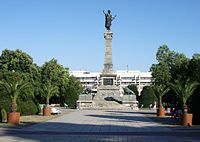
|
| Dohodno Zdanie ("Sava Ognianov" theater) | Dohodno Zdanie is an imposing Neoclassical edifice in the city centre of Ruse, built in 1898–1902 to accommodate the local theatre performances. Along with the Monument of Liberty it is a symbol of the city. | 
|
| "Aleksandrovska" street | The main street of the city is "Aleksandrovska". It is an architectural ensemble of buildings in Neo-Baroque, Neo-Rococo and other architectural styles | 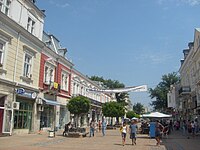
|
| The first private bank "Girdap" (The town's clock) | Girdap was the first privately-owned Bulgarian bank. Established in Ruse in 1881, Girdap was among the six largest banks in Bulgaria, and during the wars its financial group was the most influential in the country. Today the main building houses the administration of Ruse's Chamber of Control and it a favorite meeting point. | 
|
| The old city centre of Ruse | The old city centre is the square around the Rousse Historical Museum. The regional library "Lyuben Karavelov" is located on the square. The building is decorated with baroque ornaments- leaves, pearles and rosettes. The former bank of Ivan and Stefan Simeonov is situated at the beginning of "Aleksandrovska" street. The building is in the typical for Ruse, baroque style. | |
| The house of Elias Canetti, Nobel Prize laureate in Literature - 1981 | The house is located on "Slavianska" street. | 
|
| The house of Andrea Turio | The house of Andrea Turio is the most beautiful house in Ruse. It was completed in 1900. The input materials for the construction were carefully chosen from all over the world. The halls of the house are decorated in Pompeii art style. | |
| Insurance company "Bulgaria" | Insurance company "Bulgaria" was the first one in Bulgaria. It was created in 1891. The building is located on the main street "Aleksandrovska" and it was constructed in the neoclassicism architectural style. | |
| Old High School of Music | The "Old High School of Music" is an abandoned historic building, built in 1900-1901. The architectural style is eclectic, combining neoclassical and gothic revival elements and Northern European influences. The building is currently being reconstructed to become the first private museum in Bulgaria. | 
|
| The flower vase | The flower vase is located at the city's park. Its height is 3.40 metres and its width is 7 metres. |
Other landmarks are:
- Museums
- "Slavianska" street (the house of Elias Canetti is located on it)
- The house of Ivan Simeonov(The Catholic Eparchy in Ruse) and of Stefan Simeonov.
- Basarbovo Monastery
- Rousse TV Tower, the tallest TV tower in Bulgaria and one of the tallest buildings on the Balkan Peninsula .
Natural landmarks
| Site | Description | Photo |
|---|---|---|
| Rusenski lom (park) | Nature Park of Rusenski Lom is one of the ten nature parks of Bulgaria. It is situated along the canyon type valley of Rusenski Lom River - the last right feeder of the Danube. The park has been announced as a protected area in 1970 and embraces a territory of 3408 hectares. The park is recognized as an interesting and precious site of high aesthetic value preserving beautiful riverside terraces, meanders, high vertical rocks, areas of rich variety of species, caves, rock formations, historical monuments of national and international significance. | 
|
| Lipnik park | It is situated near the village of Nikolovo, 10 km away from Rusе. The park's size is around 20,000 decares and the main flora consists of linden trees. | 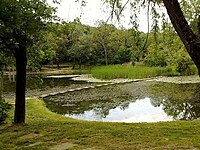
|
| Orlova Chuka (Eagle rock) | This cave is an archaeological reserve, located 8 km near Dve Mogili. The remains of prehistoric people and a cave bear were found there. The cave is the habitat of more than 10 types of bats, thousands of them living there in the winter. This is the longest cave in North Bulgaria (13 km) and the second cave by length in Bulgaria (has about 15 kilometers of tunnels at 7 levels). | 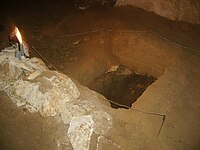
|
Education
There is one university in Ruse - "Angel Kanchev" University of Ruse with a capacity of 12 000 students. The university's structure includes a subsidiaries in Silistra and Razgrad.
There is also a subsidiary of the College of Agriculture - Plovdiv in the city.
Religious buildings

- Church of the Holy Trinity
- Church of the Holy Theotokos
- Church of St George
- Church of Holy Archangel Michael
- Church of the Holy Ascension
- Church of St Petka
- Russian Church of St Nicholas the Miracle Worker
- Roman Catholic St Paul of the Cross Cathedral, built 1890
- Armenian Surp Astvadzadzin Church
- Evangelical Baptist church
- Evangelical Methodist Church
- Seid Pasha Mosque
- Rock-hewn Churches of Ivanovo, a World Heritage Site, is situated 20 km to the south.
In 1978, the "All Saints" Church was destroyed and the Pantheon of National Revival Heroes was built thereupon.
The Jewish community in Ruse built and consecrated a synagogue in 1797. It was destroyed in the 1810 fire, but two other synagogues were later built in 1826 and 1852. [26]
Culture
Theatres and opera houses
Noted for its rich culture, Ruse hosts a philharmonic orchestra, the Rousse State Opera (founded in 1949) and the "Sava Ognianov" theater.
Museums
| Site | Description | Photo |
|---|---|---|
| Rousse Historical Museum | The Rousse Regional Historical Museum was established in 1904. It holds approximately 140,000 items, including the Borovo treasure; the finds of excavations of the antique Danube castles Yatrus and Sexaginta Prista, and of the medieval Bulgarian city - Cherven; a collection of urban clothing, china, glass, and silver from the end of the 19th — beginning of the 20th century. | 
|
| Roman fortress "Sexaginta Prista" | Sexaginta Prista is located at the city of Ruse. The name means "the port town of the sixty ships". | 
|
| Rock-hewn Churches of Ivanovo | The Rock-hewn Churches of Ivanovo are a group of monolithic churches, chapels and monasteries hewn out of solid rock, located near the village of Ivanovo, 20 km south of Ruse, on the high rocky banks of the park Rusenski Lom. The complex is noted for its beautiful and well-preserved medieval frescoes. The Rock-hewn Churches of Ivanovo are included in the UNESCO World Heritage List since 1979. | 
|
| National Transport Museum | The National Transport Museum is situated on the bank of the Danube, in the country's first railway station, built in 1866. | 
|
| "Urban lifestyle of Rousse" museum | The exposition represents the role of Ruse as a gateway towards Europe, and the influx of European urban culture into Bulgaria at the end of the 19th and the beginning of the 20th century. Sample interior layouts are shown, of a drawing-room, a living-room, a music hall and a bedroom, with furniture from Vienna, as well as collections of urban clothing, of jewelry and other accessories, of silverware (cutlery) and china, which mark the changes present in the daily life of Ruse citizens. The first grand piano, imported into Bulgaria from Vienna, can be seen here. | File:Kaliopa House.jpg |
| Pantheon of National Revival Heroes | The Pantheon of National Revival Heroes is a national monument and an ossuary, located in the city of Ruse. 39 famous Bulgarians are buried in it, including Lyuben Karavelov, Zahari Stoyanov, Stefan Karadzha, Panayot Hitov, Tonka Obretenova, Nikola Obretenov, Panayot Volov, Angel Kanchev, etc. | 
|
| The stronghold of Cherven | The stronghold of Cherven was one of the Second Bulgarian Empire's primary military, administrative, economic and cultural centres between the 12th and the 14th century. The ruins of the fortress are located near the village of the same name 30–35 km south of Rousse, northeastern Bulgaria. | 
|
| "Zahari Stoyanov" Museum | Zahari Stoyanov was a Bulgarian revolutionary, writer, and historian. The museum shows expositions from the Bulugarian Revival period and about the life and struggles of Zahari Stoyanov. | 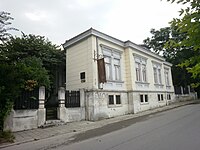
|
Libraries

- The Regional Library "Lyuben Karavelov"
- The Austrian Library, located in the 2nd floor of the theater and home of the International Elias Canetti Society.
Regular events
- The March Music Days is an international music festival for classical music.
- St George's Day (6 May) is Ruse's holiday. A local fair is organized for a week around this date.
- Ruse Carnival is a masquerade held around 24 June, Enyovden.
- The Sexaginta Prista Summer Stage is an urban festival. Events are hosted at the Roman castle every Friday from May through October.
- At the end of October are BG MediaMarket and the Bulgarian Europe Media Festival.
- The Skate-Festival "Collision Course" is taking place in May since 2007.
- Since 2008 the Literary Spring Parlour is organized by the International Elias Canetti Society in April or May.
Notable citizens
- Elias Canetti, winner of the 1981 Nobel Prize for Literature
- Albert Aftalion (1874–1956), French economist and economic situation theoretician
- Michael Arlen (1895–1956), original name Dikran Kouyoumdjian, short story writer, novelist, playwright, and scriptwriter
- Jules Pascin (1885–1930), painter
- Tanyu Kiryakov, pistol shooter, Olympic champion
- Konstantin Evtimov, solo violoncello of the Simphonic Orchestra of National Bulgarian Radio (1975)
- Vlad Kolarov, cartoonist
- Radi Nedelchev, painter
- Tonka Obretenova, 19th-century revolutionary
- Neshka Robeva, rhythmic gymnastics player and coach
- Veselin Topalov, chess player, FIDE world champion 2005-06
- Stefan Tsanev, writer
- Venelina Veneva, high jumper
- Deyan Angeloff Nedelchev,pop singer and composer -16.01.1964.
- Boyko Angeloff Nedelchev,pop singer and composer -24.04.1965.
- Atanas Kosev-composer
- Boris Chakarov-composer
- Iskren Pezov--singer,composer
- Rositsa Bordzhieva-singer,musical pedagog
- Peter Petrov-Parcheto-jazz musician
- Mimi Blakanska-opereta singer
- Kutzi Vaptsarov - show man
International relations
Consulates
Twin towns — Sister cities
|
Honours
Ruse Peak (800 m) on Livingston Island in the South Shetland Islands, Antarctica is named after the city.
See also
Gallery
-
The Rousse TV Tower as seen from the city
-
The abandoned Old High School of Music, which is to become a private museum (1900)
-
Old architecture
-
The opera-house
-
The Roman Catholic St Paul of the Cross Cathedral (1890)
-
The Court House
-
The english language school in Ruse
-
The old Credit and Trade Popular Bank (1911)
References
- ^ http://www.nsi.bg/otrasal.php?otr=19&a1=376&a2=377&a3=381#cont
- ^ "The city of Rousse - history, photos, information". uni-ruse.bg. 2003-06-25. Retrieved 2009-07-08.
- ^ [1] БНР -"Старите книги – знание и аромат от отминали времена"
- ^ [2] HISTORY OF BDZ
- ^ http://izs-ruse.org/en/istoria.php
- ^ [3] Bulgarian National Association of Shipbuilding and Ship repair
- ^ [4] БАН - "120 ГОДИНИ ОТ НАЧАЛОТО НА РЕДОВНИТЕ МЕТЕОРОЛОГИЧНИ НАБЛЮДЕНИЯ В БЪЛГАРИЯ."
- ^ [5] Българският фармацевтичен съюз(БФС)
- ^ в. "Славянин" бр. 117 от 1884 г.
- ^ [6] "FEDERATION OF THE SCIENTIFIC ENGINEERING UNIONS"
- ^ [7] "Русенската Търговско-Индустриална Камара"
- ^ History of world and national economy - Dimitar Sazdov, 2005, UNWE
- ^ [8] "The first elevator in Bulgaria"
- ^ [9] "Движещ се трен виждат русенци на първата кинопрожекция преди 110 години"
- ^ [10] "Първата чорапена фабрика в България"
- ^ http://www.petrol.bg/history.php
- ^ [11] "Mеждународен алманах за България 1898. Annuaire international de la Bulgarie. 1898 / А Дюрастел" - page 443
- ^ [12] Симеон Петров – първият дипломиран пилот
- ^ Angelova, Penka (2006). "Die Geburtsstadt von Elias Canetti". Elias Canetti: Der Ohrenzeuge des Jahrhunderts (PDF) (in German). Internationale Elias-Canetti-Gesellschaft Rousse.
- ^ http://www.grao.bg/tna/tab02.txt
- ^ http://www.sofia.bg/history.asp?lines=316&nxt=1&update=all
- ^ [13]
- ^ "Urban Bratislava". Statistical Office of the Slovak Republic. December 31, 2005. Archived from the original on December 8, 2007. Retrieved April 25, 2007.
- ^ „pop-stat.mashke.org“
- ^ Bulgarian academy of sciences-geographical institute (1887-1946) - „Bulgarian academy of sciences-geographical institute“
- ^ Teodora Bakardjieva. "The Jewish community in Ruse". Retrieved 4 M a r c h 2007.
{{cite web}}: Check date values in:|accessdate=(help); Cite has empty unknown parameter:|dateformat=(help) - ^ General consulate of Russia
- ^ Почесні консули України за кордоном
- ^ a b c d e f g h i "Ruse Municipality - Fraternize Cities". © 2008-2009 Ruse Municipality. Retrieved 2009-07-06.
{{cite web}}: External link in|publisher= - ^ "Bratislava City - Twin Towns". © 2003-2008 Bratislava-City.sk. Retrieved 2008-10-26.
- ^ "История" (in Bulgarian). Rousse.net. Retrieved 2006-11-25.
- ^ "История на Русе" (in Bulgarian). ZoneBulgaria. Retrieved 2006-11-25.
- ^ "Община Русе" (in Bulgarian). Rousse.bg. Retrieved 2006-11-25.
External links
- Ruse municipality
- History of Ruse
- Pictures from Ruse:
- Maps of Ruse


